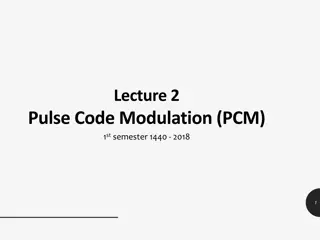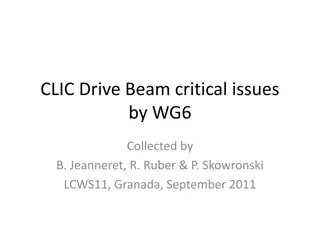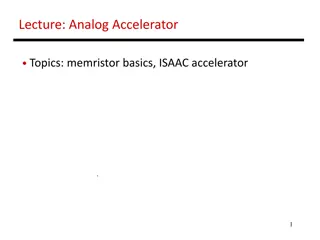Opportunistic Beam Training with Hybrid Analog/Digital Codebooks in mmWave Systems
This research focuses on utilizing hybrid analog/digital codebooks for beam training in millimeter-wave (mmWave) systems, addressing the need for efficient channel estimation and high directivity at mmWave frequencies. The study discusses system models, proposed training algorithms, codebook designs, results, and conclusions, highlighting the benefits of MIMO technology in mmWave communications.
Download Presentation

Please find below an Image/Link to download the presentation.
The content on the website is provided AS IS for your information and personal use only. It may not be sold, licensed, or shared on other websites without obtaining consent from the author.If you encounter any issues during the download, it is possible that the publisher has removed the file from their server.
You are allowed to download the files provided on this website for personal or commercial use, subject to the condition that they are used lawfully. All files are the property of their respective owners.
The content on the website is provided AS IS for your information and personal use only. It may not be sold, licensed, or shared on other websites without obtaining consent from the author.
E N D
Presentation Transcript
Opportunistic Beam Training with Hybrid Analog/Digital Codebooks for mmWave Systems Mohammed Eltayeb*, Ahmed Alkhateeb*, Robert W. Heath Jr.*, and TareqAl-Naffouri# * Wireless Networking and Communications Group, Department of Electrical and Computer Engineering, The University of Texas at Austin #King Abdullah University of Science and Technology (KAUST)
Outline Background and motivation System model Proposed training algorithm Proposed codebook design Results Conclusions 2
Why MIMO at mmWave? millimeter wave band possible bands used for cellular Several GHz of spectrum provide an abundance of bandwidth to support Gpbs data rates 7 GHz (unlic) 1.3 GHz 2.1 GHz 10 GHz 28 GHz 60GHz 37 / 42 GHz E-Band to 300 GHz Small wavelength enables small-sized arrays with many antenna elements Large arrays provide high directivity to combat path loss and reduce interference 64 element phase array [2] [1] Shu Sun, T. Rappapport, R. W. Heath, Jr., A. Nix, and S. Rangan, `` MIMO for Millimeter Wave Wireless Communications: Beamforming, Spatial Multiplexing, or Both?,'' IEEE Communications Magazine, December 2014. [2] S. Zihir, O. Gurbuz, A. Karroy, S. Raman, and G. Rebeiz, "A 60 GHz 64-element wafer-scale phased-array with full-reticle design," in Microwave Symposium (IMS), 2015 IEEE MTT-S International , vol., no., pp.1-3, 17-22 May 2015. 3 3
mmWave MIMO: need for channel estimation RF Chain RF Chain RF Chain RF Chain RF Chain RF Chain High directivity is essential at mm-wave to combat large path loss Directional precoding requires channel knowledge Low SNR before beamforming poses channel estimation challenges 4
Two main directions for acquiring the channel knowledge Explicit channel estimation Typically requires per antenna training Low SNR before beamforming RF Chain RF Chain RF Chain RF Chain RF Chain RF Chain Beam training with analog beamforming Look for best beam pair High beamfoming gain High beam training overhead RF Chain RF Chain Phase shifters 5
mmWave MIMO challenges RF Chain RF Chain RF Chain RF Chain RF Chain RF Chain Additional hardware issues Conventional architectures does not scale Array processing needs complex baseband samples High cost and power consumption Difficult to assign an RF chain for each antenna 6
Possible solution: Hybrid Architecture 1-bit ADC 1-bit ADC RF Chain RF Chain RF Beam- forming RF Combinin g DAC ADC + + Baseband Precoding Baseband Combining Baseband Precoding Baseband Precoding RF Beam- forming RF Combinin g RF Chai n + 1-bit ADC 1-bit ADC RF Chain DAC ADC Compromise on power consumption & complexity (# ADCs << # Antennas) Problem: Phase shifters have constraints, e.g., constant gains and quantized shifts Digital can correct for analog limitations [1] [1] O. El Ayach, S. Rajagopal, S. Abu-Surra, Z. Pi, and R. Heath, Spatially sparse precoding in millimeter wave MIMO systems, IEEE Transactions on Wireless Communications, vol. 13, no. 3, pp. 1499 1513, March 2014 [2] X. Zhang, A. Molisch, and S. Kung, Variable-phase-shift-based Rfbaseband codesign for MIMO antenna selection, IEEE Trans. Signal Process., vol. 53, no. 11, pp. 4091-4103, Nov. 2005. 7
Hierarchical beam training Hierarchical beam training Beam training is performed over several stages Directions that maximize the SNR are examined in the next training stages Requires codebook design 8
Prior work Adaptive beam training [1]-[2] Do not exploit BS-MS channel reciprocity Always converge to the highest resolution beams May not be optimal for delay sensitive applications Beam training codebooks Do not consider RF constraints [1][3] Array size is fixed irrespective of desired beam pattern [1]-[3] Requires large number of RF chains to realize good beam patterns [2] [1] S. Hur, T. Kim, D. Love, J. Krogmeier, T. Thomas, A. Ghosh, Millimeter wave beamforming for wireless backhaul and access in small cell networks, IEEE Trans. Commun., vol. 61, no. 10, pp. 4391-4403, Oct. 2013. [2] A. Alkhateeb, O. Ayach, G. Leus and R. W. Heath Jr, Single-sided adaptive estimation of multi-path millimeter wave channels, in the 15th int. Workshop on Sig. Proc. Adv. in Wireless Commun., June 2014, pp. 125-129. [3] J. Wang, Z. Lan, C. Pyo, T. Baykas, C. Sum, M. Rahman, J. Gao, R. Funada, F. Kojima, H. Harada, Beam codebook based beam forming protocol for multi-Gbps millimeter-wave WPAN systems, IEEE J. on Selet. Areas in Commun., vol. 27, no. 8, pp. 1390-1399, 2009. 9
Contributions Adaptive beam training Opportunistic: training is terminated once a threshold is satisfied Exploits channel reciprocity No explicit feedback channel is required Hybrid codebooks Respect RF constraints Array size is a function of the desired beam pattern 10
Hybrid mmWave MIMO system model Assumptions BS and MS employ hybrid analog/digital precoders Channels are modeled as geometric sparse mmWave channels [1][2] Perfect channel estimation at MS and BS Baseband precoder RF RF Baseband precoder precoder precoder path gain array response vectors angles of arrival/departure (AoA/AoD) (includes path-loss) [1] T. Rappaport, Y. Qiao, J. Tamir, J. Murdock, and E. Ben-Dor, Cellular broadband millimeter wave propagation and angle of arrival for adaptive beam steering systems, in Radio and Wireless Symposium (RWS), Santa Clara, CA, Jan. 2012, pp. 151-154. [2] A. Alkhateeb, O. Ayach, G. Leus and R. W. Heath Jr, Single-sided adaptive estimation of multi-path millimeter wave channels, in the 15th int. Workshop on Sig. Proc. Adv. in Wireless Commun., June 2014, pp. 125-129. 11
Proposed beam training algorithm BS and MS form S = logb K codebooks for multistage beam training. Using codebooks Fs=1 and Ws=1 the BS and MS exchange training packets BS and MS estimate channel gain s=1 If s=1 , is a QoS threshold, training is terminated If s=1< , the above steps are repeated with higher codebook levels 12
Hybrid codebook design Step 1 Design unconstraint beam pattern as follows range of angles covered by the beam digital beamforming vector array response vector for one quantized angle Step 2 Number of antennas is reduced in initial stages to match number of RF chains Allows digital beamforming in the initial stages Number of required antennas is set as N*BS = 0.891/sin( d/2NRF) 13
Proposed hierarchical codebook design Step 3 Approximate ideal pattern by solving the following problem, digital beamforming vector constrained RF beamforming vector analog beamforming matrix (due to RF limitations) 14
Proposed codebook design- An Example An example of several beam patterns K = 256, NRF = 4. N*BS= 4 in (a), 9 in (b), and 18 in (c),with 6 quantization. bit angle [1] A. Alkhateeb,O Ayach, G. Leus, and R. W. Heath Jr, Single-sided adaptive estimation of multi-path millimeter wave channels, in the 15th int. Workshop on Sig. Proc. Adv. in Wireless Commun., June 2014, pp. 125-129. 15
Performance analysis Achievable rate is upper-bounded by QoS threshold Training load (number of exchanged training packets) is upper-bounded by For tractability, we assume L=1 channel gain CDF at level s maximum training load per level Captures the possibility that the maximum receive SNR < at the sth level captures the possibility that at the sth level the receive SNR> 16
Simulation results NBS = 32 antennas NBS = 16 antennas NRF = 4 RF chains Phase-shifter quant. 4 bits BS-MS link NLOS, L=3 QoS threshold =15 dB AoAs/AoDs are uniformly distributed angles over 256 Training load versus SNR. Training load for exhaustive search is 256*256 Rate versus the average SNR Near-optimal rate performance compared to exhaustive search techniques Low training load at high SNR Simple & tight rate and load upper-bounds can be derived [10] A. Alkhateeb,O Ayach, G. Leus, and R. W. Heath Jr, Single-sided adaptive estimation of multi-path millimeter wave channels, in the 15th int. Workshop on Sig. Proc. Adv. in Wireless Commun., June 2014, pp. 125-129. 17
Conclusion Proposed an adaptive beam training algorithm for mmWave systems that Exploits channel reciprocity to terminate training when a threshold is satisfied Uses hybrid codebooks with variable array size to improve beam coverage Achieves comparable rates to exhaustive search algorithms, with lower training overhead Current hybrid codebooks do not exploit array size in their design Large number of RF chains are required to realize good beam patterns Flexible array size yields better beam patterns with lowers RF chains 18
Questions? 19























